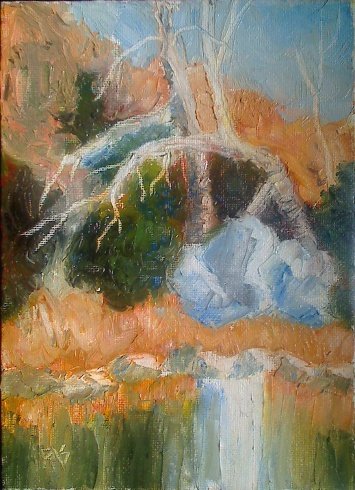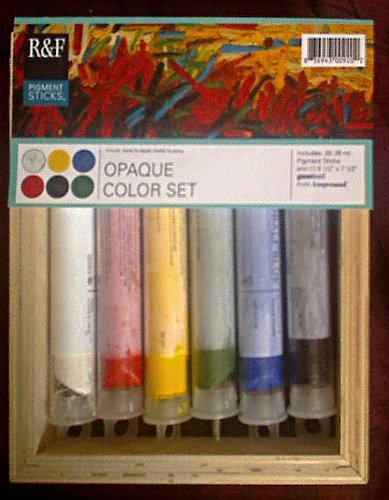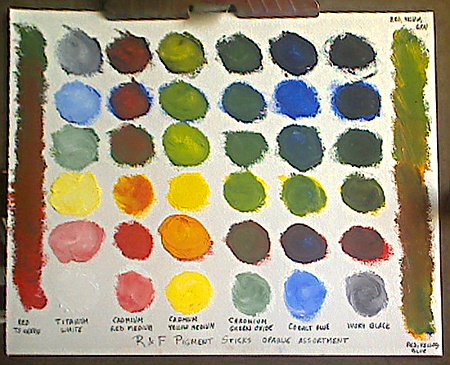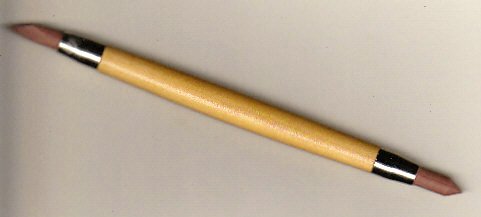|
R and F Pigment Sticks
Oil Paint in Stick FormR and F Pigment Sticks are the highest priced brand of Oil Sticks that I've found to date. There's good reason for the high price - these are pigment-rich artist grade oil paints in stick form with a bare minimum of wax added to the binder. They come in different price series like other high quality oil paints due to the cost of pigments such as real Cadmiums and Cobalts. Handle them carefully and wash up thoroughly, these R and F Pigment Sticks do contain real Cadmiums and Cobalts. As with many oil sticks, oil pastels and other products that come in sets, you'll save money purchasing assorted sets over choosing the same colors from open stock. I chose the six color Opaque Assortment to test them as this set includes Cadmium Red, Cobalt Blue and Cadmium Yellow yet the price per stick came out quite low compared to open stock. In addition to that, the R and F Pigment Sticks six color Opaque Assortment comes packed in an archival, artist grade 3/4" cradled Ampersand Gessobord. I haven't used my Gessobord yet since I want some practice with these before I test an expensive surface with them. The board itself would be worth six or seven dollars even at Dick Blick so I'll want to use that for a good painting. I still think I need more practice with oil sticks, although the example painting I did above for this review came out much better than the one I did with a selection of Winsor & Newton Oil Bars and Sennelier Oil Sticks. Below is a photo of my R and F Pigment Sticks 6 color Opaque Assortment set.

R&F Pigment Sticks Colors and SetsR and F Pigment Sticks now come in a much better Basic Assortment. I didn't like the colors in their 6 color starter for years, that put me off purchasing the most expensive oil sticks since I wanted the "set discount" pricing when I tried them out. However, recently they changed their assortment! R and F Pigment Sticks came in a Drawing Set, a Basic starter set of six colors and a Metallic set. While they kept the Drawing Set (white, black, sepia, sanguine colors) and Metallic Sets the same, they've changed the Basic set in a good way. The green used to be Cadmium Green Pale, a very light yellow-green. Now it's Chromium Oxide Green, a balanced mid-value green with good tinting strength that's a great mixer. The dark used to be Turkey Umber, now they've included Ivory Black so that you can mix with the Titanium White for a full range of grays if you like doing a grisaille layer on your oil painting. The blue was a very light Azure Blue (pthalo and white) and has been replaced with Cobalt Blue, a balanced mid-blue. The red is still Cadmium Red Medium and the yellow Cadmium Yellow Medium, so you won't get strong violets with the starter. They've also added a Translucent six color assortment that has Alizarin Crimson for a cold red, Alizarin Orange, Ultramarine, Indian Yellow, Viridian and Egyptian Violet. These two sets together would make a generous palette including warm and cool greens. Egyptian Violet is the very useful Dioxazine Violet, a good accent rolor and base for mixtures. I would personally add a stick of Quinacridone Magenta from open stock because Alizarin Crimson is too fugitive for my liking, but that's a minor quibble given the price of the sticks in sets. Last, R and F Pigment Sticks sets also include a Chiaroscuro Set of Titanium White, and five grays, if you like using grays in different values for the convenience of not having to mix them. So you can get quite a large range of these sticks at the lower unit price for sets, depending on your palette choices. Many other colors are available in open stock. I was startled to discover Yellow Ochre isn't listed as such, but Mars Yellow is a good yellow earth substitute. Some colors are convenience combinations, tints and shades, others are single pigment paints that give you the freedom of mixing your own variations. How they handle is much more like oil paint than like oil pastels. R and F Pigment Sticks are much softer than even the Sennelier Oil Sticks or Winsor & Newton Oil Bars, those are softer than Sennelier Oil Pastels. This is literally paint formed into sticks. They come packaged nicely in airtight plastic tubes with lids that pop in, so this may slow down the rate the sticks skin over if you paint with them daily. I opened mine yesterday to make a mixing chart, then carefully put them back into their tubes. Today when I opened them again to paint the Oyster Creek scene, none of them had developed any more skin than they had when I first had them out. So this is very convenient to extend the working life of your sticks. All oil sticks develop a skin over their exposed surface that has to be removed before painting with them. You can do that by swiping a painting rag or paper towel over the end, scraping it on paper to knock the skin loose or just peel it with your fingers and wash your hands afterward. The skin is an important element of the formula. It keeps the paint under the skin from drying out so that the whole stick doesn't turn solid like a split-open tube of oil paint. You lose a little paint every time you set them aside, but this is far better than losing the whole stick. Of course the first thing I asked myself about R and F Pigment Sticks on getting a six color starter set was how well they mix. Below is my mixing chart, painted on a Fredrix gessoed canvas sheet from my canvas pad. I set them up in a grid repeating the colors in rows twice so that each color combined with each of the others both on top of it and under it. On a diagonal from lower left to upper right are the pure colors.

Painting with R&F Pigment SticksPainting with R and F Pigment Sticks can be done by drawing directly on the canvas or support or by using brushes and other tools. I drew in the major masses on Oyster Creek directly with the sticks, using very light applications of darker colors and heavier applications of lighter ones over them when I wanted light mixtures. It takes a light hand to create mixes that balance exactly where you want them and some practice with those specific pigments. My mixing chart showed me that the white gives very good tints either over or under one of the colors. It behaves the same way with mixtures, so I have areas with three or four colors overlaid in the painting. As I got the major areas blocked in, I realized the stick wouldn't give me enough detail so I used a Gray Matters disposable paper palette and smeared each of the six colors on it. Then I picked them up with a Kemper Painting Tool, a rubber painting tool similar to a
Colour Shaper.

That tool is exactly the same whether it's the Loew-Cornell Paint Eraser or the Kemper Painting Tool, the only difference is the varnish on the Kemper one is darker and it's gold-stamped with Kemper Tools on it. Relatively low price compared to a Colour Shaper, it serves the same function and has both a point end and a chisel end. I painted with that to get smaller details and scraped out the light branches in the trees. With a limited palette, I did not get muddy colors even in the more complex mixtures. Once it's down on the canvas, it's got the texture of thick oil paint fresh from the tube. It can be mixed easily, scraped aside, piled up into impasto effects and handled like oils. R and F Pigment Sticks are compatible with oil paints. They're similar to oil paint used with a wax medium, something popular among oil painters. Unlike oil pastels, they dry to a durable paint film and should be cured for at least six months before varnishing. Some experts disagree on whether Oil Stick paintings should be varnished and framed like oil paintings, without glass, or framed like oil pastels with glass and no varnish. One expert recommended using a spray varnish if you do varnish because the solvent in traditional oil painting varnishes may dissolve some of the paint layer. That made sense to me so it's what I'll probably do when Oyster Creek is ready for its final varnish. It will dry to touch-dry in about the time regular oil paints would, since it's basically oil paint with a wax medium added. That'd be a week or two with how thin my applications were, might be longer if I'd used more impasto. I didn't test them with a brush but from the feel of pushing the color around with the Kemper tool, I know I could've had good results picking them up with a bristle brush to apply them or remove them, especially after mixing on a palette. They mix easily on the palette or on the canvas. A palette knife would work just as well for mixing them or applying them in thick, knife-looking impasto layers. What I like these for most is that they're a very convenient way of handling oil paint. I can draw in my initial masses and use brushes and tools to modify them or draw back into them with other colors for wet in wet effects. They can be mixed with any traditional oil painting mediums including driers like Liquin and other alkyd mediums. R and F Pigment Sticks might not be much like oil pastels at all, but they're a lot of fun and open up more possibilities in oil painting techniques than tube paints alone would. I'll want a bit more practice to get the best from my R and F Pigment Sticks but they're a good start for oil painting if you've never tried it - a bridge between drawing and painting if you're just not used to painting, or the other way for oil painters to get used to drawing as part of paint application. These are the elite, top of the line oil sticks. Priced as such, you might do best filling out this basic assortment with either the Translucent Assortment or just add Magenta and Ultramarine to have cold red and purplish blue available. Cobalt Blue doesn't have the tinting strength I'm used to from Ultramarine so I may want to pick up that Translucent Assortment along with the Magenta. R and F Pigment Sticks were well worth the investment to me. The sticks are gigantic - the small sticks are 38ml, about the size of a standard paint tube. R and F Pigment Sticks are also available in enormous 188ml giant sticks, a good bargain if you paint large as the giant ones have almost five times the quantity at a price more like three and a half smaller sticks. I will be testing and reviewing three other brands of oil sticks available at both Blick and Jerry's Artarama, the inexpensive Shiva Oil Sticks and mid-priced Winsor & Newton Oil Bars and Sennelier Oil Sticks. All of these can be used together or with traditional oil paints within the same painting, diluted with oils mediums and thinners, or extended to transparency with a clear blender. R&F Pigment Sticks does include a clear blender stick, it just wasn't in the small starter set and has to be purchased separately from open stock. Here's a look at my test painting again now that you know a bit more about how I created it. The Paint Eraser is a delightful tool for use with Oil Sticks and a way to give very large sticks more detail than just trying to draw with their edges or shaping them.

|





